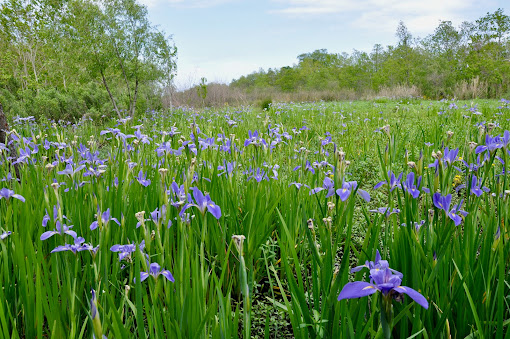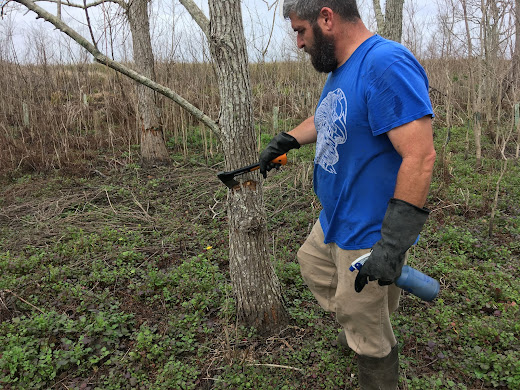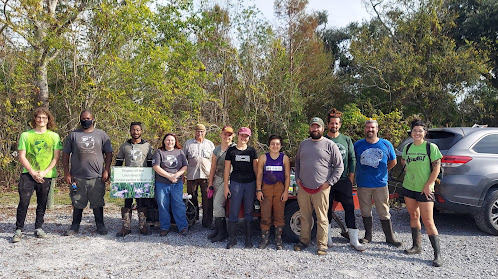By Gary Salathe
"Mission Creep," as defined by Wikipedia: "The gradual or incremental expansion of an intervention, project or mission, beyond its original scope, focus or goals, a ratchet effect spawned by initial success."
The Louisiana Iris Conservation Initiative (LICI), of which I am the founder and on the board of directors, has an on-going iris restoration project at the US Fish & Wildlife Service's Bayou Sauvage National Wildlife Refuge in New Orleans, Louisiana. The project started as a Greater New Orleans Iris Society (GNOIS) project in 2018 and LICI picked it up in 2020. Between 2018 and 2021, I organized multiple events in which volunteers from these groups replanted over 4,000 rhizomes of native Louisiana Iris giganticaerulea.
One of the challenges we faced was trying to determine the best location for planting along the old Bayou Sauvage. A few centuries ago, the bayou was a distributary of the Mississippi River. Now it is cut off from local waterways by hurricane protection levees and is a sad remnant of what it once was. Its just a rain-fed long low area. If we planted away from the shoreline, we would risk flooding irises in low areas during extreme rain. However, shoreline areas were covered in bushes and an invasive tree species; the Chinese tallow. These taller plants would have crowded out and shaded the irises. Neither was conducive to the irises blooming nor would they support conservation and long term survival.
Our solution required finding middle ground between the two extremes. The irises depend on the bayou area staying wet with rainwater. Planting irises towards the middle would increase their probability of being in moist ground for much of the year.
Hundreds of people visited the boardwalk at the Bayou Sauvage refuge to see the blooming I. giganticaerulea species of the Louisiana iris in April 2021.
From 2018 until the spring of 2021, everything went perfectly. Each year the total number of irises increased naturally and through additional plantings by my group. Then, starting in late April of 2021, a slow rolling catastrophe hit the irises at the boardwalk. By mid-September, over 84 inches of rain fell in the New Orleans area.
The water level where we planted irises would ominously rise each time it rained, but would drop back down to a high, but acceptable, level within a few days. The irises all bloomed and things looked like they might calm down during our usual hit-and-miss summer thunderstorm season. However, the thunderstorms were a little more hit than miss. Water never dropped to its usual summertime level, and then Hurricane Ida came blowing through and dumped unusually heavy rain on the area. The water rose to a level where many already weakened irises were submerged for more than a few days—too long for the plants to tolerate. It quickly became apparent that were going to lose about 60% of the irises.
Not ready to be defeated by Mother Nature, we regrouped and came up with a plan: kill the invasive tallow trees and create open areas along the shoreline. We could plant these higher areas with irises and reduce the risk of them going underwater again. Fortunately, many of the bushes along the shoreline also died from water levels remaining too high for them to survive. The tallow trees however, like many invasive species, are talented survivors and showed no ill side effects from being in standing water for extended periods of time.
A LICI volunteer using the "hack and squirt" method of killing a Chinese tallow tree with an herbicide.
We received a permit from the US Fish & Wildlife Service (which always gets very excited and grateful when someone wants to kill tallow trees in one of their refuges) and went to work on the tallow trees. I put together a group of four volunteers to meet Monday mornings at the refuge and spend three-hours each time killing Chinese tallow trees. It was very satisfying work.
The Chinese tallow tree can be easily spotted in Louisiana forests when their leaves change color in late fall. In the early 1900s it was used as an ornamental tree in Louisiana because most of the state's native trees typically do not produce fall-colored leaves. The leaves of most native Louisiana hardwood trees turn tan or brown in color each fall.
At the refuge, Chinese tallow trees had taken advantage of huge areas of bare ground that were created by the destruction from Hurricane Katrina in 2005. They got a head start on the native trees that would usually naturalize in these areas. Since the Chinese tallow trees grow faster than native tree species, they out-compete the native trees that would otherwise reforest the damaged areas.
Not long after we started work on killing tallow trees we ran into a Loyola University biology professor on the refuge that has an on-going twenty-year research project there. He told us if we only killed off the tallow trees along the shoreline where we wanted to plant irises the area would just be reseeded by nearby tallow trees we didn't kill. He said we needed to kill off all of the tallow trees in the boardwalk area. "I've seen other groups come and go killing tallow trees, but the tallow trees always come back," he warned us.
This little tidbit of motivational talk got the crew to agree on expanding our goal by killing all of the tallow trees in the boardwalk area and resolving to come back each year to address tallow trees trying to get reestablished.
A pure stand of Chinese tallow trees canopied over this area of the Bayou Sauvage refuge and successfully shaded out native trees attempting to grow. As more of these areas were discovered it became apparent that a reforestation effort would be needed once the tallow trees were killed off.
We also bumped into the staff biologist while working at the refuge. He shared with us that to make our project a success we needed to plant native trees in any areas where dense stands of Chinese tallow trees were killed off. We would need to plant a desirable native tree in these areas since the tallows had long ago shaded and killed off all of the native trees that tried to get established among them.
"If you don't, the newly-opened areas will just grow back as a new tallow tree forest from birds bringing seeds in," he stated in a very serious tone. He also broke the news to us that the refuge did not have the money or staff to order or plant these new trees. He then hopped into his pickup truck and drove off. After this second little tidbit of motivational talk, the crew agreed to expand our goal to include replanting native trees in all of the areas where we were going to kill off the tallow trees.
After working for months, our little crew had killed off around 4,000 Chinese tallow trees. Now at the end of October, we were eager to begin the next phase of this moving-target project. I approached our friends at Common Ground Relief, a local non-profit involved in marsh restoration projects using out of state college student volunteers. They agreed to donate hundreds of one and three gallon pots containing live oaks and cypress trees from their Wetlands Nursery. Many of these trees were outgrowing their containers due to COVID-19 causing college student volunteers to be unavailable the last two years to plant them in their restoration projects.
Common Ground Relief told me that they needed to find a home for the trees quickly because an order of smaller trees was scheduled to arrive in a couple of months. I asked if they would like to become a partner in the reforestation portion of the project and provide some volunteers to plant their trees and our irises. Thankfully they agreed.
Most of the trees that were planted at the Bayou Sauvage refuge during the project were donated by LICI's partner in the project, Common Ground Relief. The co-director of Common Ground Relief, Charlotte Clarke, is seen in the center of the photo among volunteers from AmeriCorps as they collect trees for that day's planting at the Bayou Sauvage Refuge. Charlotte was responsible for the donation from Common Ground Relief.
The effort to replant areas of the refuge involved many volunteers that did not actually plant any of the trees. The potted trees used in the plantings had been growing at the Common Ground Relief's Wetlands Nursery in New Orleans for the last two to three years. They have required huge amounts of time and energy from Common Ground Relief's staff and local volunteers to plant trees into containers, keep them watered, and pull weeds from the pots twice each year.
Volunteers from Tulane University are shown loading some potted cypress trees being donated by Common Ground Relief onto my trailer to be delivered to the Bayou Sauvage refuge.
To get the collaboration going, Common Ground Relief donated over 300 three-gallon potted live oak trees and a total of 400 one and three-gallon bald cypress trees from the Wetlands Nursery in early November. They also ordered and donated 200 live oak, 400 cypress and 50 American elm bare-root seedlings for the project and then donated 50 additional bare-root cypress seedlings from their nursery. The US Fish & Wildlife Service also donated a total of 500 other types of oak and green ash tree seedlings that were left over from a tree planting at another refuge.
I organized multiple events between early December 2021 and mid-January 2022 to plant the trees. These events involved eight to 17 volunteers planting the potted trees and bare-root tree seedlings. The every Monday morning work crew switched gears from eradicating Chinese tallow trees to planting the new trees from early November 2021 until February 17, 2022, when the last trees were planted.
Refuge manager Shelley Stiaes (center) and New Orleans city councilman Oliver Thomas (behind Shelley) came out to welcome volunteers for the tree planting event in December 2021. The Friends of the US Fish & Wildlife Refuges, Inc. were also present to support volunteers with snacks and hot chocolate. This group of volunteers was from Saint Paul's Catholic Student Center at the University of Wisconsin - Madison and were hosted in New Orleans by Common Ground Relief for a week of service activities.
The effect of the volunteers' work killing the tallow trees and planting new trees at the refuge became visible to refuge visitors over the last few months. Word had started spreading about the project—two local TV stations, WDSU and Fox 8 News, each became interested in the story and asked to do an interview with those involved.
In conjunction with the tree planting, we also planted Louisiana irises along the old Bayou Sauvage shoreline as time allowed and volunteers were available. Our goal was to add 2,500 Louisiana irises to the refuge during this winter's iris planting season while simultaneously pursuing our goal of planting 1,900 trees.
Volunteers from LICI, Common Ground Relief and GulfCorps/Limitless Vistas came together for a tree planting and iris planting event at the Bayou Sauvage refuge on December 6, 2021.
Next, I was contacted by The Nature Conservancy. GulfCorps, through Limitless Vistas, Inc., has supplied workers for our iris restoration project at the Bayou Sauvage refuge during the last two years. GulfCorps is a partnership of The Nature Conservancy and the National Oceanic and Atmospheric Administration. GulfCorp's purpose is to do job training for hundreds of young adults by restoring the natural features and habitats on critical conservation lands along the Gulf of Mexico. Restoration of our country's wetlands is becoming a very important and growing industry.
Limitless Vistas does job training of GulfCorps members in Southeast Louisiana.
The Nature Conservancy's GulfCorps Conservation Information Manager, Karrie Arnold, has recently begun a program to collect base data on long-term projects that GulfCorps workers are participating in. She will make subsequent annual visits to monitor the success of each project. She asked the manager of the Bayou Sauvage refuge if she could monitor LICI's iris restoration project and the work that the GulfCorps workers are doing for it. The manager agreed, so Karrie drove in from Alabama for one of the iris planting days at the refuge involving the GulfCorps workers. I, of course, welcomed the involvement of this nationally-recognized organization and find it exciting that they are so interested in our project.
Common Ground Relief volunteers planted Louisiana irises at the Bayou Sauvage refuge in December, 2021.
So...what started out as an iris restoration project morphed into a Chinese tallow tree eradication project. This further evolved into a major tree planting project—which planted 1,900 trees. It then settled back down as an iris restoration planting project with over 2,500 irises in the ground. After we were finished, we learned the irises would be studied by a national conservation organization for years to come. Whew! What an adventure.
When I titled this article "Mission Creep and Conservation of Louisiana Irises" I really didn't give any hints as to whether this was a good thing or bad thing. However, there is no question that this odyssey ended up being the most consequential and satisfying project I have taken on since I embarked on this whole "iris restoration plantings" thing four years ago. A big bonus for me is that along the way I have had the opportunity to meet some wonderful people of all ages and backgrounds willing to get out there and spend the time and effort to make a difference. In this case, "mission creep" has been a very good thing indeed.
The Louisiana Iris
Conservation Initiative website can be found here: https://www.licisaveirises.com/
Recent articles about
our work can be found here: https://www.licisaveirises.com/news
Our Facebook page can be
found here: https://www.facebook.com/licisaveirises/

















What an amazing story of interconnectedness of all things - truly inspiring irisians who understand how the Cypress matter to the iris!
ReplyDelete